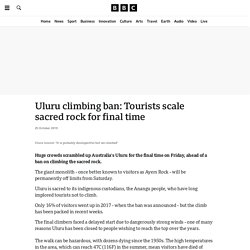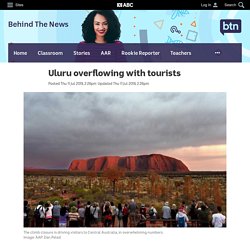Zoom
Trash

Dismantling of Uluru climb to begin on October 28 despite continued opposition to ban. Parks Australia plans to start dismantling the world-famous Uluru climb two days after it closes tomorrow (on October 26), despite pressure to reconsider the climbing ban.

The removal of 138 steel posts, a chain and white markings pointing the way to a cairn* at Uluru’s summit should begin on October 28 and be complete by January 31, 2020, according to tender* documents issued by the Director of National Parks. Taking down the posts and other material is controversial because it forms part of heritage claims lodged by those seeking to stop the climb closure. The climb is scheduled to close under a resolution* of the Uluru-Kata Tjuta National Park Board of Management passed in November 2017. Aboriginal traditional owners have long objected to tourists walking on the rock, where there are many sacred sites, and say they would prefer to develop tourism opportunities of their own. Uluru climbing ban: Tourists scale sacred rock for final time. Media playback is unsupported on your device Huge crowds scrambled up Australia's Uluru for the final time on Friday, ahead of a ban on climbing the sacred rock.

The giant monolith - once better known to visitors as Ayers Rock - will be permanently off limits from Saturday. Uluru is sacred to its indigenous custodians, the Anangu people, who have long implored tourists not to climb. Uluru Uproar - Classroom - BTN. It's known as the heart of Australia - a 348m high sandstone outcrop in the middle of the desert, that seems to change colour as the outback sun moves across its ochre face.

With a stunning landscape like this, it's no wonder hundreds of thousands of visitors trek out to the red centre, near the exact centre of Australia, to take a look. But many don't just enjoy the view from the bottom. About a third of tourists decide to climb all the way up to the top - the equivalent of hiking up an 85 storey building! The climb generally leaves visitors with a smile on their face, but the fact they can do it at all hasn't left everyone happy. Uluru Climbing Ban - Classroom - BTN. PAUL HOGAN: You look like you need a holiday, a fair dinkum holiday.

In a land of wonder, the land down under. For a long time, this big red rock has been right at the heart of Aussie tourism. Uluru Tourists - Classroom - BTN. EMMA DAVIS, REPORTER: It's one of our country's most amazing natural landmarks and looking at Uluru like this you can understand why hundreds of thousands of people come to visit it every year.

That's a great thing for businesses in the area and the people who work here. But the way some tourists have been behaving lately is causing controversy. Uluru overflowing with tourists - Newsbreak - Behind The News - BTN 2019. Tourists are rushing to get to Uluru before October 26.

Ban on Uluru climbs. Visitors will be permanently banned from climbing Australia’s popular tourist attraction Uluru within two years.

The Uluru-Kata Tjuta National Park Board yesterday announced tourists would not be permitted to climb the huge monolith*, an activity long considered disrespectful by the region’s traditional owners, from October 26, 2019. The symbolic date is the 34-year anniversary of the day Uluru and the surrounding land were handed back to its traditional owners, the Anangu people. The two-year delay on the ban will allow tourists who booked trips to the red centre* to complete the climb, if they choose to do so. Chairman of the park board Sammy Wilson said the Anangu people wanted visitors to respect the site. “It is an extremely important place, not a theme park like Disneyland,” he said. Uluru climbs banned from October 2019 after unanimous board decision to 'close the playground' Updated 1 Nov 2017, 10:41amWed 1 Nov 2017, 10:41am Climbing Uluru is set to be a thing of the past after the Uluru-Kata Tjuta National Park board decided unanimously to ban the activity, starting in 2019.

How would a ban be enforced? Under Commonwealth laws, there are steep fines for people who ride or walk in a Commonwealth reserve and go off trackThe management board could have all walking tracks on the rock removed, making any climb illegalIn practical terms, a chain currently in place could be removed, which would make climbing Uluru physically difficultUnder NT legislation, sacred sites including Uluru have special protections, and a serious breach of the Sacred Sites Act can lead to penalties of more than $60,000 and two years' jail The board, made up of eight traditional owners and three representatives from National Parks, made the decision after consulting with the wider Anangu community, who it said was overwhelmingly in support of banning climbs. "Please don't hold us to ransom. Should We Climb Uluru? Uluru: Australia's rock of ages - Lonely Planet travel video. Uluru Street View: 13/06/2017, Behind the News.
For the first-time kids will be able to walk around Uluru without actually travelling to the centre of Australia.

It's one of Australia's most iconic sites, Uluru. Located in the very centre of Australia, this rock is about 350 metres tall and thought to be around 300 million years old. White settlers first spotted Uluru in the 1800s and gave it the name Ayers Rock. But Aboriginal people had been living in the area thousands of years before that. And they already had their own name for this sacred site - Uluru.
SAMMY WILSON, TRADITIONAL OWNER: Many people come to this place and often think it’s just a place, a site in the landscape. Meet Uluru’s traditional owners. ‘This is not Disneyland’: Traditional Owners ban Uluru climbs. The Traditional Owners of Uluru have announced today that the culturally significant site will be closed to visitors from October 26, 2019.

Today the Uluru-Kata Tjuta National Park Board of Management unanimously voted to close the site to climbers. Chairman and senior Traditional Owner Sammy Wilson said the decision to close the climb came after extensive consultation. "Over the years Anangu have felt a sense of intimidation, as if someone is holding a gun to our heads to keep it open. Please don’t hold us to ransom," he said in an address to the board today. “More recently people have come together to focus on it again and it was decided to take it to a broader group of Anangu. Uluru Climbing Ban: 07/11/2017, Behind the News. Uluru is one of Australia's biggest tourist attractions but it's been decided that from 2019 onwards, visitors will no longer be able to climb the famous rock.
It's something traditional owners have been fighting for, for many years. Here's a look at the debate that led to this historic decision. PAUL HOGAN: You look like you need a holiday, a fair dinkum holiday. In a land of wonder, the land down under. For a long time, this big red rock has been right at the heart of Aussie tourism. Uluru Handback: 27/10/2015, Behind the News. Thirty years ago the most famous rock in Australia, Uluru, was officially handed back to its traditional Aboriginal owners. Next up we have Eloise with the story behind the historic handback.
But first a warning to Aboriginal and Torres Strait Islander viewers, this story contains images of people who've died. The message is clear: please don't climb Uluru 2013. Analysis Posted 3 Jun 2013, 1:47amMon 3 Jun 2013, 1:47am. Uluru Uproar: 21/07/2009, Behind the News. It's the rock in the middle of the desert that attracts 350,000 people each year, but soon those visiting Uluru, in the centre of Australia, might not get to see as much of it as they'd like.
A plan has recommended closing the rock to all climbers. That's got a lot of people fired up... so let's take a look at those on each side of this ascending argument. Plan to ban climbers from Uluru 2009. News Online's Jano Gibson Updated 8 Jul 2009, 7:26amWed 8 Jul 2009, 7:26am Climbing to the top of Uluru could be banned in the near future under a proposed draft plan for the popular Central Australian tourist destination.
The Director of National Parks today released a draft 10-year management plan for the Uluru-Kata Tjuta National Park, which is visited by about 350,000 people a year, about half of whom are from overseas. The traditional landowners have long been opposed to people climbing the 346 metre high rock, which is considered sacred. Safety concerns have also been raised, with more than 35 deaths recorded on the climb, which can be steep, slippery and extremely hot. Uluru debate: to climb or not to climb? 2009. Updated 8 Jul 2009, 10:07pmWed 8 Jul 2009, 10:07pm A proposed ban on climbing Uluru in Central Australia has sparked debate between tourists, traditional owners and political leaders. A draft management plan for the Uluru-Kata Tjuta National Park was released today, recommending a ban for cultural and environmental reasons.
The plan could come into effect within 18 months, but must first go through a consultation process and be signed off by Federal Environment Minister Peter Garrett. The Northern Territory's Tourism Minister, Chris Burns, says the Territory Government does not back the proposal.